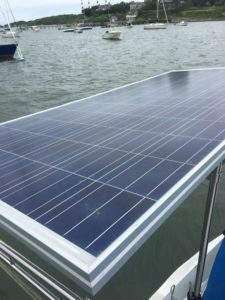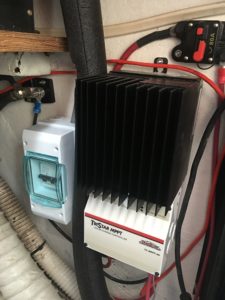This 3 15 watt panel replaces an aging 75 watt panel. With 75 watts, I could keep the batteries fully charged on the mooring, It could handle an occasional bilge pump cycle and makeup for the normal self-discharge of the batteries. Three hundred plus watts adds the ability to keep the refrigerator running all summer long, run Risa-Pi, the Raspberry-Pi based boat monitoring system that includes several cameras and a wifi connection to the internet. Remember that we are not concerned with maintaining this power output in winter (The power needs diminish dramatically as we won’t need the refrigerator in the off season.)
15 watt panel replaces an aging 75 watt panel. With 75 watts, I could keep the batteries fully charged on the mooring, It could handle an occasional bilge pump cycle and makeup for the normal self-discharge of the batteries. Three hundred plus watts adds the ability to keep the refrigerator running all summer long, run Risa-Pi, the Raspberry-Pi based boat monitoring system that includes several cameras and a wifi connection to the internet. Remember that we are not concerned with maintaining this power output in winter (The power needs diminish dramatically as we won’t need the refrigerator in the off season.)
I mounted the panel over my dinghy davits -raising it to be at the same height as my bimini. A ten degree slope keeps the birds from perching on it and allows the rain to keep it clean.
As these larger panels put out voltages higher than a 12 volt system can use, a MPPT (Maximum power point tracking) charge converter should be employed.  It will convert the power at the 30-50 volt output of these type panels (mine is around 37 volts) to the voltage required by the system for charging. I chose the Morningstar Tristar-60 model. While it has much more capacity than I need (could handle three 300 watt panels), it had two features that appealed to me: 1. A built-in network connection. and 2. No fan to wear out in a salt-water environment. It is mounted next to a battery charger in a lazarette. To the left of the charge controller is a (weatherproof) double pole circuit breaker/array disconnect. The cable to the battery is protected on both ends -near the charge controller (pictured above Tristar MPPT-60) and near the battery, as current can originate from either.
It will convert the power at the 30-50 volt output of these type panels (mine is around 37 volts) to the voltage required by the system for charging. I chose the Morningstar Tristar-60 model. While it has much more capacity than I need (could handle three 300 watt panels), it had two features that appealed to me: 1. A built-in network connection. and 2. No fan to wear out in a salt-water environment. It is mounted next to a battery charger in a lazarette. To the left of the charge controller is a (weatherproof) double pole circuit breaker/array disconnect. The cable to the battery is protected on both ends -near the charge controller (pictured above Tristar MPPT-60) and near the battery, as current can originate from either.